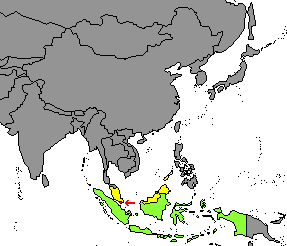 |
This 60-card pattern is traditionally used by Indonesian and Malaysian
players of Chinese descent.
About one century ago, the gambling game of Ceki (other Western spellings: Cheki or
Tjeki), also known as Kowah, was particularly popular among the
Babas and Nyonias ethnic groups living in Malacca (Malaysia), but it is still played today
by the descendants of such immigrants. Click on this LINK to see pictures from an old book that features the main subjects of the deck.
This pattern has very strong analogies with the classic Chinese DongGuan cards (see
Chinese gallery part 1): there are values from 1 to 9 of the
suits of Coins, Strings and Myriads, plus the "Old Thousand", "Red Flower"
and "White Flower" cards, and their illustrations are very similar too.
Therefore, Ceki cards are a further variety of money-suited cards. |
|
In Ceki decks each subject is duplicated twice, and there is no Gui
(or "devil") card; therefore, the pack contains only 60 cards. But since the game requires two decks
(120 cards in total) for being played, a clear analogy with the aforesaid Chinese pattern
can be told. Furthermore, the game of Ceki is not very different from Mah Jong,
whose cards belong to the money-suited group, as well.
In the Ceki pattern the suit of Myriads has an actual Wan sign
(not a Guan), as can be seen on the right in the first card of the bottom row.
The faces of the characters from The Water Margin novel appear very stylized,
more than in Chinese patterns, almost as if they had become a mere graphic
detail to fill the central part of the card, yet they can still be told.
In most editions the backs of Ceki cards are plain yellow.
Both Indonesian and Malaysian editions have different proportions from the usual size
of Chinese cards: they are almost closer in size to a Western patience pack than to any
other money-suited card variety. |
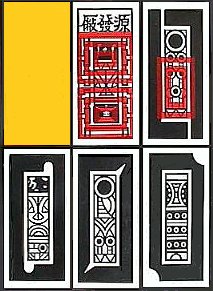
Ceki deck by Guan Huat (Hong Kong),
showing "Old Thousand", 9 of Strings,
2 of Myriads, 3 of Strings, 1 of Coins;
note the different frame patterns |
A peculiar feature of Ceki cards is a thick frame or rim that encloses the central illustration.
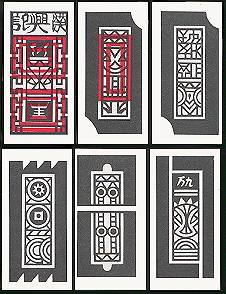 |
|
There are nine different frame patterns, and all cards with the same value
(for instance: the 3 of Coins, the 3 of Strings and the 3 of Myriads) have identical
ones, although they belong to different suits.
A similar index system is also found in other money-suited patterns used in China (see
Chinese gallery page 1).

table of Ceki frames and numerical values they match
left: an edition by Pendekar ~ Woo Sung (Indonesia):
"Old Thousand", "Red Flower", "White Flower",
(bottom row) 7 of Coins, 4 of Strings, 9 of Myriads
|
|
Apparently, these frames have the same purpose as indices in Western decks, i.e.
they help players to tell at a glance the numerical value of the card. In fact, the only
two combinations pursued in the game of Ceki, the couple and the "three of a kind",
are both irrespective of suits (a 5 of Coins and a 5 of Myriads form a couple,
a 7 of Strings and two 7s of Coins are "three of a kind", and so on); therefore, the
numerical value of a card is a much more important detail than its suit.
The four of Strings has an additional horizontal break in the center of the illustration
(see the previous picture), while two of the special cards, "Red Flower" and "White Flower",
have a frame similar to 1s.
The whole deck is shown in the Ceki page, with
detailed instructions for the game. |
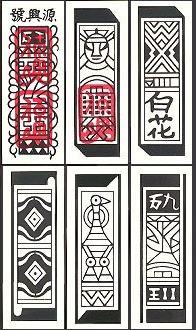
Single Lion brand (Yong Guan Heng, Malaysia):
"Old Thousand", "Red Flower", "White Flower",
(bottom) 2 of Coins, 3 of Strings, 9 of Myriads |
FOUR COLOUR CARDS
Throughout South-eastern Asia, players of Chinese descent use four colour cards (see the Chinese gallery, page 2). Some of the
local short variety editions, though, have only half the number of cards of the standard Chinese
editions, i.e. 56 versus the usual 112 cards of the traditional Si Se Pai.
In fact, in some cases each
of their subjects is duplicated not four times, but only twice.
In other cases, instead, the deck has four of each subject, but only two colours or suits, namely yellow and red (i.e. the two most valuable ones), also in this case counting a total of 56 cards.
Curiously, the wrapper of the latter decks still reads "Four Colour Cards", in spite of the two lacking suits. |
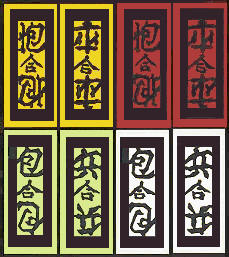
four colour cards manufactured
in Belgium for export to Indonesia:
the sample above features
a Cannon and a Soldier of each colour |
|
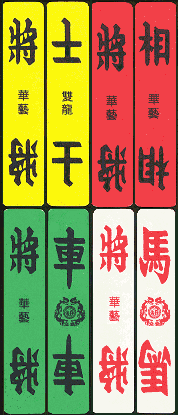
edition by Hua Goi Pte Ltd.,
Double Dragon Brand (Singapore) |
In Singapore, instead, the long variety prevails, manufactured by a local firm (Hua Goi Pte Ltd., Double Dragon Brand).
The cards are locally known as  Si Sek Pai, i.e. literally "four colour cards" in the Hokkien dialect, spoken by the majority of the Singaporean Chinese.
Si Sek Pai, i.e. literally "four colour cards" in the Hokkien dialect, spoken by the majority of the Singaporean Chinese.
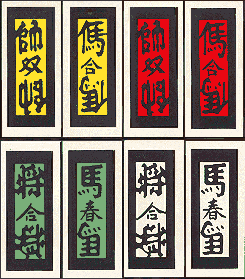
four-suited cards from Indonesia
(General and Horse are shown) |
Besides these differences, the patterns are identical to the ones used in China: the rank is shown by means of a character borrowed from Chinese chess, repeated at both ends of the
card, while the background colour (yellow, red, green or white) expresses the family or suit, and
a different character or small drawing, merely for decorative purposes, fills the central space.
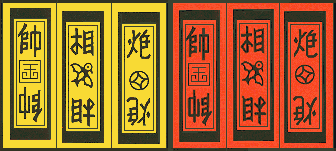
two-suited cards from Malaysia; the only colours
are yellow and red (General, Minister and Cannon are shown) |
MAH JONG CARDS
Decks of cards for the game of
Mah Jong (or
Majong, as spelt on the boxes)
are manufactured in Malaysia. The name of the firm remains obscure, not being mentioned. They are the size variety closer to Western cards (i.e. not the very thin type, more often used in
Hong Kong).
For an in-depth description of the standard composition of a set, see the Chinese gallery,
page 2. Malaysian ones, either made of cards or tiles, traditionally comprise some extra subjects which are only partly found in southern China, and are not found at all in the north; the selection featured below shows some of them. Besides the 144 regular ones, this edition includes four jokers (the ones that in the Cantonese area are sometimes called wild cards, or "100 purpose cards"), four animal cards (Rooster, Cat, Mouse and Centipede), and even two full sets of Flower and Season cards, which makes sixteen extras, all together.
A further interesting detail is that Malaysian
Mah Jong decks sometimes bear advertisement on their backs, as this specimen does.
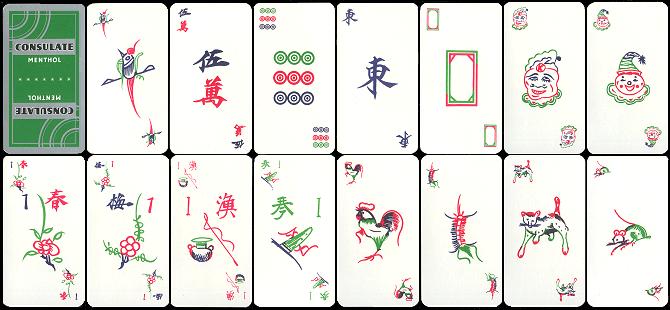
Malaysian edition with a rather extended composition, comprising jokers,
(bottom row) double Seasons and Flowers, and animal subjects;
also note the advertisement on the back
go to
OTHER GALLERIES






















or back to

INTRODUCTION
AND HISTORY
|

MULTI-LANGUAGE
GLOSSARY |

THE FOOL &
THE JOKER |

INDEX
TABLE |

REGIONAL
GAMES |

PLAYING CARD
LINKS |